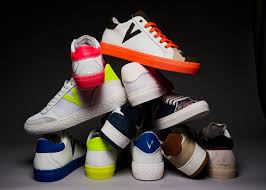Sneakers, once limited to gymnasiums and playgrounds, have evolved into a multibillion-dollar industry, dictating global fashion trends and acting as powerful cultural symbols.
From their modest beginnings as quiet-soled alternatives to clunky leather shoes, sneakers now represent innovation, identity, and status.
Whether you’re a professional athlete, a style-conscious urbanite, or a nostalgic collector, sneakers hold a unique place in your wardrobe—and perhaps even in your heart.
This transformation spans more than a century, intersecting developments in sports, design, pop culture, and even politics. This article explores how sneakers moved from the sidelines to center stage, shaping the worlds of fashion, identity, and commerce.
The Etymology: Why They’re Called ‘Sneakers’
The word “sneakers” might sound modern, but its roots trace back to the late 19th century. In 1887, the Boston Journal of Education recorded the term being used by schoolboys who appreciated how rubber-soled shoes allowed them to move about without making a sound. In contrast to the traditional leather shoes of the time, which clacked and echoed across wooden floors, rubber soles were silent. These shoes, by design, enabled wearers to “sneak” around unnoticed, thus earning the playful moniker “sneakers.”
Some attribute the term’s rise in popularity to Henry Nelson McKinney, a prominent advertising agent for N.W. Ayer & Son, who reportedly used “sneakers” in a 1917 campaign. However, historical evidence suggests the term had already been in common use long before this marketing push.
This etymological origin—stealth and comfort—still resonates today, especially as modern sneaker designs often emphasize lightness, agility, and subtle luxury.
The Evolution of Sneakers: A Century of Change
1. The Birth of Rubber-Soled Footwear (Late 1800s to Early 1900s)
The first real iteration of sneakers came in the form of plimsolls in the 1860s. These early versions featured a simple canvas upper and a thin rubber sole, designed primarily for sporting and recreational use.
While primitive by today’s standards, they were revolutionary at the time, offering unprecedented comfort and flexibility compared to rigid leather shoes.
In the United States, 1916 marked a pivotal moment when the U.S. Rubber Company launched Keds, widely recognized as the first mass-produced sneaker brand. With their canvas bodies and rubber soles, Keds sneakers were marketed as ideal for both leisure and light athletics. They also marked the first time shoes were marketed as “sneakers” in a commercial sense, cementing the term into the public lexicon.
2. The Rise of Athletic Sneakers (1917–1940s)
Sneakers began their rise in athletic prominence with the launch of the Converse All-Star in 1917. Originally designed for basketball, these shoes gained legendary status when basketball player Chuck Taylor endorsed them in the 1920s. His name was added to the ankle patch, birthing the “Chuck Taylors” we know today. By the 1940s, the Converse All-Star was the go-to basketball shoe for players across the United States.
Across the Atlantic in Germany, two brothers—Adolf (Adi) and Rudolf Dassler—were laying the groundwork for a sneaker empire. In the 1920s, they launched the Dassler Brothers Shoe Factory. Their shoes gained attention when American athlete Jesse Owens wore them during the 1936 Berlin Olympics, winning four gold medals.
Following a bitter fallout, the brothers went their separate ways in 1948. Adi Dassler founded Adidas, and Rudolf Dassler established Puma. These two brands would go on to dominate the athletic shoe market and form the basis of global sneaker rivalries for decades to come.
3. Sneakers Enter Pop Culture (1950s–1970s)
The post-World War II era saw sneakers becoming deeply embedded in youth culture. No longer just for athletes, sneakers started showing up in films, music, and everyday fashion.
The rebellious image of teens in jeans and sneakers was epitomized by James Dean in Rebel Without a Cause. His red jacket and casual sneakers became an iconic look associated with teenage angst and nonconformity.
During the 1960s and 1970s, the jogging boom in America dramatically reshaped the sneaker landscape. Influenced by a growing awareness of personal health and fitness, running became a national obsession. Brands responded by engineering sneakers with enhanced cushioning, arch support, and breathability.
Nike, founded in 1964 (originally as Blue Ribbon Sports), introduced its first pair of shoes with a waffle sole in 1974, revolutionizing grip and traction for runners.
This period also marked the first attempts to treat sneakers not just as gear but as lifestyle items. Sneaker designs began to reflect not just functionality, but personality.
4. The Sneaker Culture Explosion (1980s–1990s)
The 1980s and 1990s brought an unparalleled explosion in sneaker culture, with the emergence of celebrity endorsements, hip-hop influence, and streetwear aesthetics.
In 1985, Nike released the Air Jordan 1, designed for the NBA’s rising star, Michael Jordan. The NBA banned the original colorway because it didn’t match team uniforms, but Nike turned the controversy into a marketing goldmine.
The rebellious aura around the “banned” sneaker only heightened its appeal. The Air Jordan line would go on to become one of the most successful sneaker franchises in history, creating a fervent subculture of collectors and fans.
Meanwhile, the hip-hop community embraced sneakers as a core element of their visual identity. Groups like Run-D.M.C. proudly wore Adidas Superstars without laces, making the shoe a symbol of street authenticity. Their 1986 track “My Adidas” led to the first non-athletic endorsement deal between Adidas and a musical act—a groundbreaking moment in sneaker history.
This era also saw the emergence of sneaker design as an art form. Brands experimented with bolder colors, futuristic shapes, and tech-inspired features. Reebok Pump, Nike Air Max, and LA Gear lights captured the imagination of youth everywhere.
5. Sneakers as Fashion Statements (2000s–Present)
The new millennium ushered in a new era of sneakers as fashion statements, merging the worlds of high fashion, streetwear, and athletic wear.
Luxury houses like Balenciaga, Gucci, and Louis Vuitton began producing high-end sneakers, collaborating with artists and designers to create limited editions that sold out in minutes. Collaborations between brands and celebrities—like Kanye West’s Yeezy line with Adidas or Travis Scott’s partnership with Nike—blurred the line between footwear and fashion art.
The rise of sneakerheads—devoted fans and collectors—created a booming resale market. Online platforms like StockX, GOAT, and Stadium Goods turned sneakers into digital commodities, with certain rare models fetching prices upwards of $10,000. The thrill of limited releases and raffles added to the exclusivity and desirability of sneaker culture.
At the same time, sustainability became a major focus. Brands like Allbirds, Veja, and Nike’s Move to Zero initiative began emphasizing eco-friendly materials and ethical production processes. Sneaker companies now compete not only in design and performance but also in environmental responsibility.

Technology, too, plays a role in shaping the future. Nike’s self-lacing Adapt BB, released in 2019, brought a sci-fi concept to life, while 3D-printed midsoles and smart insoles are quickly becoming realities.
Sneakers in Global Culture: Beyond Fashion
Sneakers today are global cultural signifiers, transcending boundaries of age, race, and class. They’re worn by athletes on world stages, artists in music videos, CEOs in boardrooms, and schoolchildren in rural communities.
In some regions, owning a particular pair of sneakers is a marker of status and aspiration. In others, it’s a practical necessity. Yet across all demographics, sneakers often reflect personal identity, subcultural affiliations, and economic power.
Sneaker events like Sneaker Con draw thousands of fans and collectors worldwide. Museums now host exhibits on sneaker history, and books dissect the sociopolitical impact of iconic shoes. Films and documentaries, such as Unbanned: The Legend of AJ1, explore how a single pair of sneakers helped redefine everything from race relations to marketing psychology.
From Tokyo to Lagos, New York to Johannesburg, sneakers have become a shared language of style, passion, and creativity.
The Digital Era and the Metaverse: Sneakers Go Virtual
In the past few years, the rise of digital fashion has brought sneakers into the metaverse. Brands are now creating virtual sneakers that can be worn by avatars in video games or digital social platforms. Companies like Nike and Adidas have invested in NFTs (non-fungible tokens), offering collectors exclusive access to digital designs paired with limited physical releases.
The virtual sneaker market might seem abstract, but it signals a major shift in how fashion and identity are experienced in increasingly digital lives.
The Sole of Society
Sneakers are no longer just shoes. They are narratives on your feet—telling stories of athletic triumph, cultural rebellion, artistic vision, and global commerce.
Their journey from stealthy rubber soles to luxury catwalks speaks volumes about how society evolves, how identities are expressed, and how innovation intersects with style.
Whether you’re a casual wearer, a performance athlete, a collector, or a designer, sneakers today represent far more than functionality. They are, quite literally, a movement—one that continues to walk, run, and sprint into the future.

